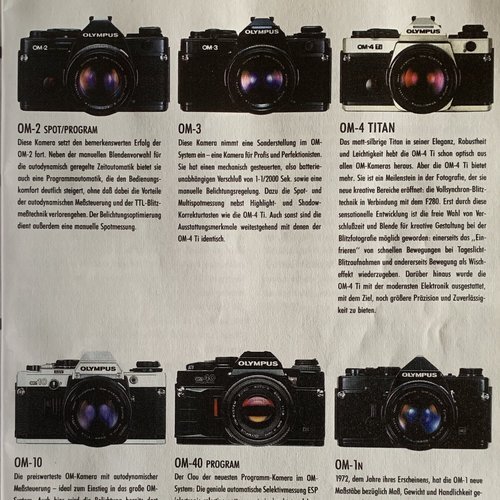Highlight and Shadow
A small declaration of love to the Olympus OM-4 Ti
Sometimes you take a camera in your hand and immediately have a special relationship with it. It is not necessarily the best camera in its class. But often technology or features do not tell you the whole story.
For me this camera, the Olympus OM-4 Ti.
A first overview of the Olympus OM-4 Titan
From the Olympus brochure - translated from German to English:
OM-4 Titan
"The matt-silvery Titan in its elegance, robustness and lightness lifts the OM-4 Ti out from all OM cameras. But the OM-4 Ti offers more. It is a milestone in photography, opening up new creative areas: full-sync flash technology in conjunction with the F280. Only through this sensational development has it become possible to freely choose shutter time and aperture for creative design in flash photography: on the one hand, the "freezing" of rapid movements in daylight lightDisplay flash shots and motion as a wiping effect. In addition, the OM-4 Ti has been equipped with the most modern electronics with the aim of providing even greater precision and reliability."
Technical Specifications
35mm single-lens reflex camera
Dimensions and weight: 136 x 84 x 50 mm und 510g (body only), 759g Olympus OM-4 Ti, Olympus Zuiko Auto-W 35mm 1:2
Mount: Olympus OM-Mount
ISO sensitivity: ISO6-ISO3200, exposure compensation
Shutter: Electronically controlled focal-plane shutter
Shutter speeds: 1s - 1/2000s and Bulb
Flash sync: 1/60s and longer. High speed flash sync (up to 1/2000s) with the Olympus F280
Film advance: Film transport lever
Film return: Winder
Battery: 2xLR44/SR44
The OM-4 Ti in the OM-System
The Olympus OM-4 Ti was launched in 1987 as a successor to the Olympus OM-4 and was built until 2002. Initially, the OM-4 Ti was only available in matt silver/champagne and later a black painted version was added.
The Olympus OM-4 Titan has been developed for professional photographers and is the most technically developed camera in the OM system.
In 1989, the OM-4 Titan had an appearance in the title sequence of the James Bond film "License to Kill".
Diffrences between the Om-4 and the OM-4 Ti
Unlike the Olympus OM-4, the base and top plate of the OM-4 Titan are made of titanium. The battery life of the OM-4 Ti was dramatically improved. The Olympus OM-4 Ti is the first camera on the market to feature fully synchronous flash technology. However, this requires the Olympus F280 flash unit. With the Olympus Power Bounce Grip 2 and the Olympus TTL Auto Cord F0.6m even the indirect use of HSS flash is possible.
FEATURES OF THE OLYMPUS OM-4 TI
The Olympus OM-4 Titan is a relatively light, compact and small camera. Compared to its competitors with a manual focus, this is particularly evident:
Nikon F3 - dimensions and weight: 148 x 96,5 x 69 mm and 700g
Canon New-F1 - dimensions and weight: 147 x 97 x 48 mm and 795g
Pentax LX - dimensions and weight: 144,5 x 90,5 x 50 mm and 565g with the FA-1 Viewfinder
Minolta X-700 - dimensions and weight: 137 x 89 x 51,5 mm and 505g
Leica M6 - dimensions and weight: 138 x 77 x 38 mm and 560g
Leica R6 - dimensions and weight: 138,5 x 89,1 x 63,5 mm and 635g
One again, let's compare the dimensions and weight of the Olympus OM-4 Ti: 136 x 84 x 50 mm and 510g.
The design follows that of the Olympus OM-1 and its successors and can be described as simple and elegant. It is not for no reason that the Olympus OM-1 is considered to be the SLR camera that Leica would have liked to build. Of course, this assumption refers to the combination of design, functionality, compactness and robustness.
Built for the most extreme conditions, the Olympus OM-4 Titanium is known for its outstanding build quality. The camera is aimed at professional photographers.
The OM-4 Ti, just like its predecessor OM-4, has a brilliant light metering system. Besides center-weighted integral metering, the camera offers spot metering and multi-spot metering (maximum 8 spots), plus highlight and shadow buttons for very bright or very dark motifs. In addition to manual tracking measurement, the camera offers automatic timer. In addition, the OM-4 Ti, like the OM-4, has the possibility to save spot metering values.
Shooting with the OLYMPUS OM-4 Ti
A tool that is also visually convincing is a pleasure to hold in your hand and use.
In my humble opinion, the Olympus OM-4 Ti - like its predecessors - claims this attribute for itself. Especially in black it is simple and elegant.
The camera sits well in the hand. All buttons, switches and controls are easily accessible. As usual in the OM system, the aperture is controlled on the lens. The shutter speed is set on a time dial/ring on the bayonet mount. To reach the red times B (Bulb) and 60 (1/60s - mechanical emergency time), the B-Lock button must be pressed while changing the shutter. On the front of the camera, next to a 12 second self-timer and the PC sync port, is a button for illuminating the viewfinder. On the upper side, there is a film transport lever, rewind button, ISO- and exposure correction, rewind lever, a mode switch (between MANUAL and AUTO), through which the battery can be controlled at the same time and of course a release button with the possibility to attach a cable release.
So far, the Olympus OM-4 Ti is not very different from its competitors. But apart from the buttons just mentioned, the OM-4 Ti has a button for spot metering, a highlight and a shadow button, as well as a switch on the shutter release button with which the results of the spot metering can be saved or deleted.
With these buttons there is a lot happening on the upper side of the camera and the handling of the OM-4 Ti requires concentration and practice, but for me the spot (in combination with the highlight/shadow buttons) and multi-spot metering is outstanding.
The Highlight and Shadow buttons allow very quick control of very light or dark motives. By using the multi-spot measurement, a conversion/application of the zone system of Ansel Adems is possible. The measurements made can be stored or deleted by a switch on the trigger.
Final Thoughts
Although the OM-3 Ti was released by Olympus in 1995, the OM-4 Ti is the high and low point of the OM system. Because the OM system was designed exclusively for manual focusing, it can increasingly fall behind the systems of other camera manufacturers. In 1987, for example, the Canon EF bayonet and the first Canon EOS camera appeared, whose autofocus increased Canon's supremacy. Until the OM mount was discontinued in 2002, the OM system had a niche existence, which is a real pity in my eyes.
For me the Olympus OM-4 Ti is my favourite 35mm camera, despite or maybe because of its limitations.
What experiences have you made with the Olympus OM-4 Ti? Let me know your thoughts about the Om-4 Ti in the comments.
I appreciate comments and suggestions, as well as Likes.

































